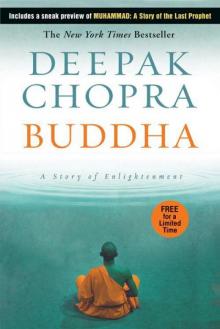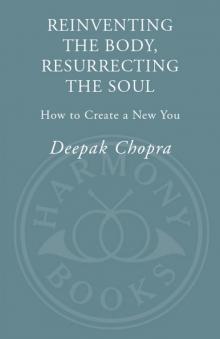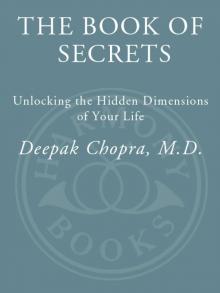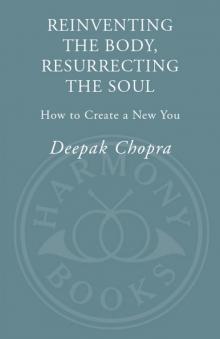- Home
- Deepak Chopra
Reinventing the Body, Resurrecting the Soul Page 3
Reinventing the Body, Resurrecting the Soul Read online
Page 3
Neurologists would likely label such experiences artifacts of the brain, the kind of sensory distortions created by hallucinogens, epilepsy, and severe mental illness. But whether that’s accurate or not, it seems the body’s physical limitations can suddenly and unexpectedly disappear. Aiden went on.
“I know now that this kind of experience isn’t as freakish as you might think. People have out-of-body episodes all the time. They have visions of angels; they intuit events before they happen. Who hasn’t thought of a friend who calls you up on the phone the next minute? But people soon forget these experiences, or dismiss them as tricks of the mind. I went the other way. I took my experiences seriously. I wandered off the map.”
We were talking in a meditation center in midtown Manhattan where both of us often saw each other in passing. I knew lots of people with similar stories. Most are fascinated by the prospect of reaching higher states of consciousness. So was he.
“We assume we know what’s real and what’s not, but the line is much fuzzier than people think,” he said. “I saw a news program about a priest in Brooklyn who cures people of chain-smoking. He sits a group of them in his living room and seems to do nothing. But he’s going inside and envisions a beam of holy light coming into his body. He asks God to relieve everyone in the room of their smoking habit, and that’s it. They walk out and never smoke again. There’s a healer in Santa Monica who discovered his calling when a neighbor showed up. She had developed a case of warts that covered her whole body. One night she dreamed that her neighbor could cure her simply by touching her. So she knocked on his door and told him about her dream. He was shocked; he wanted her to go away. But the woman was desperate, and basically to humor her he touched her. Within a day or two every wart had vanished.”
Did you see such healing on your own? I asked. Aiden nodded. “Healing exists everywhere, but there’s a general level of resistance that keeps people from seeing and accepting it.” His conviction was obvious. As for where he is now in his journey, he sees himself as a work in progress.
“I’ve passed through a lot of phases,” he said. “I’ve chased a lot of ideals and had many disappointments. Did I get close to God? Do I think I’m enlightened? I’ve stopped worrying about those things.”
“What did you learn, then?” I asked him.
“I got put back together. My life isn’t confusing anymore. I know that I have a source, and being close to the source is a million times better than wandering around with no clue about who you are.”
“So you’re the same person who started out on this path?” I said.
Aiden laughed. “I wouldn’t even recognize him. Looking back, I can see that I was living in disguise. I took off the mask, and everything changed.”
He was talking about self-transformation, a word that has become a cliché, but still has a very real basis. The key to transformation is that you create the change you want to see in yourself (which echoes Gandhi’s advice that you must become the change you want to see in the world). In this case, the first changes came in Aiden’s body. He wasn’t by nature a spiritual seeker. He was probably helped by having no religious or spiritual ideas at all. Having no preconceptions, he was open to change when it came along.
The future of an illusion
Yet change is also a choice. Your body is alive with unknown abilities, but it looks to you for direction. When you introduce a new intention, your body finds a way, on its own, to adapt to anything you want. An example of this has been occurring over the past few years. The younger generation has been developing a brain with new capabilities. Researchers find that children who grow up with video games, iPods, e-mail, texting, and the Internet (so-called “digital natives”) generate different brain activity from those who grew up in an earlier generation. Their brains grew sharp in one area—the skills needed to access information quickly and play video games, for example—but dull in other areas that emphasized social bonding and the ability to recognize emotions. If you are the opposite of a digital native (the term for you is “digital naïve”), a week’s exposure to playing a video game or using the Internet intensively will stimulate your brain to shape itself to conform to your new digital environment.
Once you change the brain, social norms change along with it. Earlier generations of children learned about the world nested inside a tight-knit family, and so they became social creatures. More recent generations, on the other hand, spend hours a day alone at the computer, and experience a loose-knit family, and often no family at all. They have therefore become clumsy at empathy and social contact. Researchers have known, thanks to a breakthrough now twenty years old, that the brain is “plastic”—adaptable to change, not fixed at birth. Now they face the fact that simple daily activity quickly creates new neural networks. And there seems to be no limit to what the new brain can become.
It can deliver spiritual experiences. In fact, if the brain hadn’t created a neural network for tuning in to spirit, there could be no experience of God. It was only in the past few years that medical science caught up with this fact. With the cooperation of His Holiness the Dalai Lama, brain researchers were able to study advanced Buddhist monks who had been meditating between fifteen and forty years. In the laboratory the monks were hooked up to functional MRIs, a type of brain scan that can monitor changes in real time.
The monks were asked to meditate on compassion. In Tibetan Buddhist teaching, compassion is the capacity to help any living creature at any time. As they meditated, the monks began to generate the most intense gamma waves ever seen in a normal brain. Gamma waves are associated with keeping the brain functioning as a whole, and also with higher thinking. The most intense area of activity displayed by the monks was in the left prefrontal cortex, just behind the left side of the forehead. This area is associated with happiness and positive thoughts.
The researchers were elated with their findings, because this was the first time anyone had shown that mental activity alone can alter the brain. It was already known that the brain could be trained in its physical performance—athletes, for example, get better the more they practice. We praise them for having talent, will, and courage. All of that may be true. But to a neurologist, the greatest runners, swimmers, and tennis players have highly trained their motor cortex, which is responsible for coordinating the complicated movements needed in any difficult sport. Now it could be shown that the mere wisp of desire—in this case the desire to be compassionate—trains the brain to adapt in the same way.
Mysticism is also at work here. A form of love is holding sway over solid matter. Jesus may have spoken in metaphor when he said that faith no greater than a mustard seed can move mountains, but the force of love can literally move the brain. We were all taught—and have accepted without question—that the brain is a “computer made of meat,” to use the brutal phrase from a prominent expert in artificial intelligence at MIT. One piece of hardware, the cortex, is programmed to think, while another, the limbic system, is programmed for emotions. But this hard-and-fast division turns out to be false. If you took a snapshot of the activity in your brain at the very instant you had a great idea, dozens of areas in your brain would be lighting up, and for each new idea, a subtly new pattern would be present. A computer, by contrast, lights up the same circuit boards each time any command is given. The notion of “hard wiring” fits a computer. The brain, which can rewire itself in a split second, is obeying invisible forces totally unrelated to computers.
How, then, can we translate this into everyday life? Experimenters at Harvard have shown the immediate effect of love on the body. Subjects sat in a room to watch a film of Mother Teresa and her work with abandoned children in Calcutta. As the viewers watched the deeply moving images, their breathing rates and blood chemistry changed, revealing greater calm and less stress. These responses are controlled by the brain.
If even a brief exposure to higher love creates a new brain response, what about the effects of love in the long run? Older couples who enjo
y a good marriage have been studied, and they report that they love each other more after thirty or forty years than when they first fell in love. But they also report that it’s a different kind of love, not the overwhelming infatuation that poets compare to madness, but a steadier, more constant, deeper love. This suggests that like the Tibetan monks, happily married couples are experiencing a change in their brains. There certainly are striking resemblances between the two groups. The monks exposed their minds to a state of calm, openness, peace, and “non-doing,” to use a common Buddhist phrase. The brain got used to that unbounded state, and thus it escaped from its own conditioning. Long-standing lovers also experience calm, peace, and openness around each other. Exposure to each other has done the work of meditation.
Subtle action
I’ve been making an argument that the nonphysical aspect of life is stronger than the physical. Talk of invisible forces may sound overly mystical, but at the personal level we can’t disconnect love, a purely invisible force, from the body, and we don’t need science to prove that falling in love ignites an intense physical change. Once you stop clinging to the idea that your body is a thing, you realize what should have been obvious: your body is the junction between the visible and invisible worlds. Standing at this junction, you are constantly advancing into new regions of the invisible world. For every new step you take, your body follows.
I call these new steps subtle actions, because they involve only the mind, whereas gross actions involve direct contact with the material world. Although subtle action comes naturally to all of us, it can be broken down into steps, as follows:
How Subtle Action Works
You go inside and make your intention known.
You believe in getting results.
You don’t resist the process of change.
Your body shifts effortlessly at the physical level.
You repeat your subtle action until you have mastered the change you desire.
The Tibetan monks accomplished all these steps. They meditated in order to make contact with higher consciousness (Buddhists wouldn’t use the word soul). They sat quietly, trusting that they would reach their goal. They practiced their discipline diligently, keeping the goal in sight. Through subtle action alone, using no effort or physical struggle, compassion flowed into them. (I am reminded of a famous saying in India that wisdom isn’t something you learn, it’s something you become.)
If invisible forces really do have power, then a subtle action—one entirely located in the mind—should be able to create even greater change than a gross action. And so it turns out. Subtle action translates into uncanny physical ability. There’s another Tibetan meditation called tumo that protects the body from the elements. Monks who practice tumo can sit in caves overnight at subzero temperatures clad only in a thin silk robe, and at dawn they emerge unaffected. The secret, according to Western medical observers, is that the monks have raised their internal temperature by as much as eight degrees Fahrenheit, a heat that utilizes a specific area of the brain, the hypothalamus. Body temperature is ordinarily an automatic response, yet through subtle action a person can move this response at will.
Biofeedback experiments with ordinary people in the West have followed this example. Subjects are asked to focus on a small patch of skin on the back of their hand and will it to grow hot. Without long practice, many could raise their skin temperature enough, simply through focused attention, so that a red patch appeared on the back of the hand.
Yet Western medicine is baffled by yogic practices in India that go a step further. Yogis have trained themselves in meditation to need only minimal food, barely a hundred calories a day. They have been buried in coffins for days, surviving on tiny amounts of air by lowering their breathing rates and basal metabolism. The most advanced yogis are reputed by Western observers to sit so firmly in samadhi (deep awareness) that they cannot be pushed over with physical force.
This doesn’t mean that subtle action only works in a biofeedback lab or after years of spiritual discipline. The invisible powers that can be manipulated in such specific ways are everywhere and play a part in every aspect of life. We label them as intelligence and creativity, and see them in action when a white cell devours invading bacteria. Nobel Prizes have been given for figuring out just a fraction of the chemistry involved in immune cells, which turn out to be so complex that now the immune system is known as a “floating brain.”
The discovery of intelligent cells did nothing, however, to break down the old model of the physical body. Instead we wound up with a paradox. If a white cell is intelligent, how did it get that way? It’s not part of the billions of interacting neurons in the brain. If you are a cell biologist, you must locate a white cell’s intelligence in its proteins and enzymes, but those are only simpler molecules linked together, so are simple molecules smart? They are made up of even simpler atoms. Are atoms smart? It would seem quite strange to think that the same carbon we find in a lump of coal is intelligent enough to build a macrophage, along with a handful of other atoms like oxygen and hydrogen.
Should carbon share the Nobel Prize, since it’s part of every brilliant brain? Yet you are stuck with this reductio ad absurdum unless you want to say that intelligence is an invisible force that white cells happen to express. And that’s the very thing a cell biologist—or any physical scientist—cannot conclude, because everything about life, from DNA on up, must have a material basis. How much easier it would be to admit the obvious, that intelligence is an invisible force, one that our bodies use extravagantly. Your body’s whole purpose is to join the visible and invisible realms, and intelligence isn’t the only force that wants to express itself through you. So do creativity, truth, beauty, and love.
Sometimes it takes a stroke of revelation to bring this home. A man named Damon is returning home to Denver from a routine business trip. Damon steps off the plane expecting to fetch his luggage and take a cab home. Out of the corner of his eye he sees his wife, who has decided to surprise him by meeting him in the reception area.
Damon recalls, “She was just standing there smiling, but in my chest I felt this leap of joy. I don’t remember having such a feeling since we first fell in love. It caught me completely off guard, so much so that when my wife walked up, she saw a look on my face. She asked me how I was feeling. I wanted to say ‘I love you’ more than anything in the world. But I didn’t. We had been having problems; she wasn’t in the best mood. So I just said I was fine, and we started walking toward baggage claim. But that moment haunts me. I don’t know where such intense love came from, but it was so sharp and clear. Sad to say, I never felt comfortable bringing it up again.”
Love catches us off guard, because we wander around in a haze of busy activity and predictable events. To have a breakthrough, you must consciously connect with the invisible forces that are everywhere around you, urging you to go beyond your old conditioning. A sudden burst of love must be expressed and acted upon, or else it disappears, and ordinary life takes over once more. Subtle action is urgent and necessary. It invokes these invisible forces and brings them into your body. Once you experience the change that makes, there’s no reason to cling to the fiction of being physical any longer.
In Your Life: The Action of Love
Subtle action can make the difference between dreaming of an ideal love and achieving it. In ordinary life, love has become entangled with something else, usually the ego. By nature the ego is selfish, and although love appeals to it, the ego wants to have love on its own terms. These must be sorted out. One person may want to be in control, another to be taken care of. One may feel insecure no matter how much love is directed her way, another may have to dominate his partner in order not to feel vulnerable. But pure love exists, and it can be found. As with everything else, a process is involved. You begin where you are, and you grow through subtle action—that is, you quietly encourage the kind of love you really want.
In your own life, consider the qualities of love at the
highest level. The soul’s love is
unselfish
giving
blissful
warm and safe
self-sufficient, needing no outside validation
innocent
uncomplicated
kind, compassionate
constant
expanding
comforting
sacred
These are terms you’ve heard all your life, and you have experienced them either a little bit or a great deal. Sit quietly and summon the memory of one quality, such as kindness, including your memories, visual images, emotions, and people connected with this quality. Stay with your experience for a few minutes. Let it deepen of its own accord. In effect, you are subtly directing your mind to access the quality of kindness, which forms a neural pattern that differs from a mind that doesn’t dwell on kindness.
In the same way, you can go within yourself and feel, as completely as possible, what “giving” or “sacred” means to you. Taking one quality at a time, pay attention to it until you have a clear sense of its personal meaning. What moment of love was most unselfish in your past? Can you recapture a sense of innocence, perhaps walking in the woods or gazing at the sea?
Don’t try to get through the whole list at one sitting. Return to it every day, and as you do, build up an inner sense of your connection to love. Subtle action works by reaching for a deeper level of awareness. As you become more aware of the love that is inside you, you align with an invisible force. Quietly but steadily, you will find that the higher qualities of love will start to enter your life.

 Muhammad: A Story of the Last Prophet
Muhammad: A Story of the Last Prophet Buddha
Buddha Power, Freedom, and Grace
Power, Freedom, and Grace Reinventing the Body, Resurrecting the Soul: How to Create a New You
Reinventing the Body, Resurrecting the Soul: How to Create a New You The Book of Secrets: Unlocking the Hidden Dimensions of Your Life
The Book of Secrets: Unlocking the Hidden Dimensions of Your Life Muhammad
Muhammad Reinventing the Body, Resurrecting the Soul
Reinventing the Body, Resurrecting the Soul